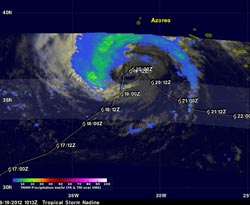NASA Satellite Sees Fading Rainfall in Tropical Storm Nadine

NASA's TRMM captured Nadine's rainfall rates at 6:13 a.m. EDT on Sept. 19, and showed no rainfall was occurring near Nadine's center. Rainfall around Nadine's center was falling at 20mm~0.8 inches per hour. Nadine's past and predicted path with appropriate symbols is shown overlaid in white. (Credit: SSAI/NASA, Hal Pierce)<br>
A tropical storm warning is in effect on Sept. 19 for the islands of Flores, Corvo, Faial, Pico, Sao Jorge, Graciosa, Terceira, Sao Miguel and Santa Maria in the Azores.
The Tropical Rainfall Measuring Mission (TRMM) satellite flew over Nadine on Sept. 19 at 1013 UTC (6:13 a.m. EDT) and captured data on rainfall rates occurring within the tropical storm. TRMM's Microwave Imager (TMI) and Precipitation Radar (PR) data showed that no rainfall was occurring near Nadine's center. The maximum precipitation intensity found in rain bands around Nadine was only about 0.8 inches (20mm) per hour. The lack of convection (rising air that forms the thunderstorms that make up the tropical cyclone) is a sign that the tropical storm is decaying or weakening.
NASA's Hurricane Severe Storms Sentinel (HS3) Mission plans to send one of the unmanned Global Hawk aircraft to investigate Nadine again on Wednesday, Sept. 19.
On Sept. 19 at 11 a.m. EDT Tropical Storm Nadine's maximum sustained winds were near 50 mph (85 kmh). Nadine was located about 270 miles (430 km) west of the Azores islands, near 37.2 north latitude and 31.8 west longitude. Nadine is moving toward the north-northeast near 5 mph (7 kmh) and is expected to start drifting to the east-southeast. Nadine's estimated minimum central pressure was 993 millibars.
According to the National Hurricane Center, early on Sept. 19, Corvo in the Azores reported sustained winds of 42 mph (68 kmh) with a gust to 58 mph (93 kmh). In addition, ocean swells continue to affect the Azores and are causing life-threatening surf conditions and rip tides.
The National Hurricane Center noted that if Nadine continues to show weaker convection, it may no longer qualify as a tropical or subtropical cyclone.
Text credit: Rob Gutro
NASA's Goddard Space Flight Center, Greenbelt, Md.
Media Contact
More Information:
http://www.nasa.govAll latest news from the category: Earth Sciences
Earth Sciences (also referred to as Geosciences), which deals with basic issues surrounding our planet, plays a vital role in the area of energy and raw materials supply.
Earth Sciences comprises subjects such as geology, geography, geological informatics, paleontology, mineralogy, petrography, crystallography, geophysics, geodesy, glaciology, cartography, photogrammetry, meteorology and seismology, early-warning systems, earthquake research and polar research.
Newest articles

Webb captures top of iconic horsehead nebula in unprecedented detail
NASA’s James Webb Space Telescope has captured the sharpest infrared images to date of a zoomed-in portion of one of the most distinctive objects in our skies, the Horsehead Nebula….

Cost-effective, high-capacity, and cyclable lithium-ion battery cathodes
Charge-recharge cycling of lithium-superrich iron oxide, a cost-effective and high-capacity cathode for new-generation lithium-ion batteries, can be greatly improved by doping with readily available mineral elements. The energy capacity and…

Novel genetic plant regeneration approach
…without the application of phytohormones. Researchers develop a novel plant regeneration approach by modulating the expression of genes that control plant cell differentiation. For ages now, plants have been the…





















